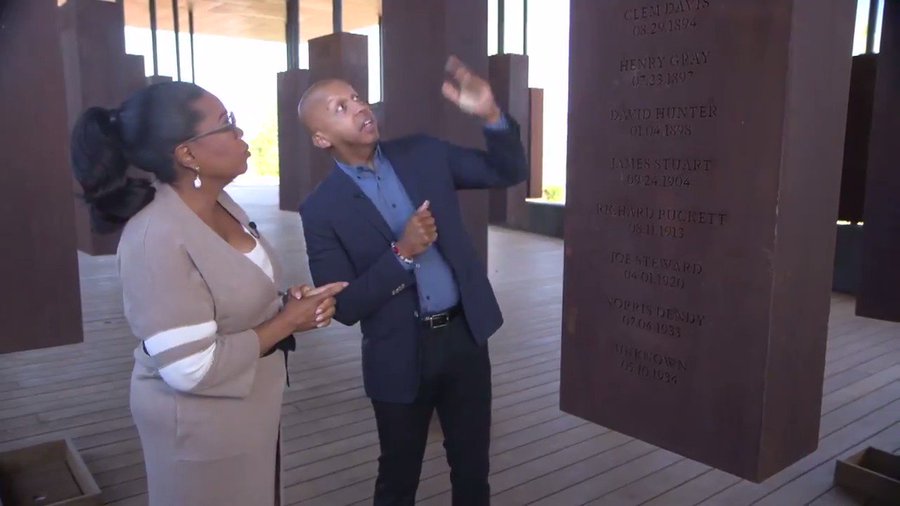Oprah wants you to know why 805 steel markers hang from the ceiling at this museum.
APRIL 10, 2018
Oprah wants you to know why 805 steel markers hang from the ceiling at this museum.

by Kayla Stewart
Share this story
There’s a new memorial and museum in Montgomery, Alabama, that Oprah Winfrey wants the world to see.
The Legacy Museum and The National Memorial for Peace and Justice open on April 26.
In a segment on “60 Minutes” that aired April 8, Oprah was given advance access to the museum and memorial, and in her report, she identified the “reckoning taking place in America over how we remember our history.”

Share
Photo by John Phillips/Getty Images.
It’s one of the first museums in the history of the United States to memorialize black lynching victims in our country.
The museum and memorial are a product of the Equal Justice Initiative (EJI), an organization that works to end mass incarceration and excessive punishment in the U.S., challenge racial and economic injustice, and protect the basic human rights of our country’s most vulnerable individuals.
EJI is led by Bryan Stevenson, a historian, public speaker, and lawyer who has dedicated his career to advocating for the poor, incarcerated, and otherwise condemned in America.

Share
Bryan Stevenson. Photo by Frazer Harrison/Getty Images.
For years, our history books have ignored or downplayed the epidemic of lynching in the United States.
A multi-year investigation from the EJI helped change the false narrative. Researchers documented:
“4,075 racial terror lynchings of African-Americans in Alabama, Arkansas, Florida, Georgia, Kentucky, Louisiana, Mississippi, North Carolina, South Carolina, Tennessee, Texas, and Virginia between 1877 and 1950 — at least 800 more lynchings of black people in these states than previously reported.”
The National Memorial for Peace and Justice is showcasing the names of victims on the markers that hang from the ceiling.
The reality is harsh. But it’s important that we recognize our history so it doesn’t become our future.


Oprah Winfrey
✔@Oprah
Tonight on @60minutes, we go inside The National Memorial for Peace and Justice. 805 steel markers, each bearing the names of the thousands of victims of lynching. Thank you Bryan Stevenson and @eji_org for this first look.
3:30 AM - Apr 9, 2018
15.3K
6,400 people are talking about this
Twitter Ads info and privacy
The memorial has 805 steel markers, one marker for each county where lynchings took place. The magnitude of it is staggering — during Winfrey’s tour with Stevenson, she was shocked to see just how many names there were.
“Every name has its own story,” Winfrey said.
“If they couldn’t find the man they were looking for, they would lynch that man’s wife or daughter or child,” Stevenson said, of the horrific lynchings.
ADVERTISEMENT

Share
Each marker lists the names of lynching victims. Image from “60 Minutes.”
As Stevenson has noted in a number of interviews, owning up to America’s history of racial injustice is a huge challenge, but one that is worth it. If we can actually accept our nation’s failures, we can move toward a place where we won’t let our worst moments define us.
The United States can move beyond the horrors of our past — it’s happened elsewhere before.
Despite hosting one of the most lethal genocides in the world’s history, Germany has largely managed to admit to and move forward from the Holocaust.
The nation hasn’t done this by hiding out from reality, though. Instead, German schools teach children about the Holocaust early on, and multiple museums there allow citizens and visitors to reflect on the horrific acts.
Germany owns up to its inequity and has policies in place that criminalize anti-Semitic and white supremacist behavior.
ADVERTISEMENT

Share
Photo by Jerry Lampen/AFP/Getty Images.
America is a great nation, but for far too long, privileges have been granted to far too few.
We believe in freedom, democracy, and the rights to individual liberty and prosperity. But historically, those privileges existed only on the backs of people whose humanity was stripped from their lives. It’s tragic and horrific, but it does not have to be our story.
“There is a strength, a power even, in understanding brokenness, because embracing our brokenness creates a need and desire for mercy, and perhaps a corresponding need to show mercy,” Stevenson once wrote. “When you experience mercy, you learn things that are hard to learn otherwise. You see things you can’t otherwise see; you hear things you can’t otherwise hear. You begin to recognize the humanity that resides in each of us.”
By amplifying the voices that were buried; recognizing their existence, their lives, and their pain; and ending similar behavior in our prisons, neighborhoods, and school systems, we can move toward a place where America’s promise becomes our central reality.
We can do better — and The Legacy Museum and The National Memorial for Peace and Justice are great ways to start.
No comments:
Post a Comment